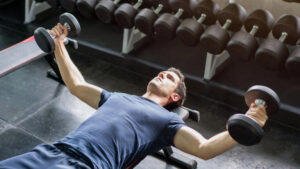JANUARY 2, 2023

Dumbbell flyes. – Shutterstock
Some exercises can leave you wondering why on earth you put yourself through them (I’m looking at you, squats of all kinds), and some leave you with a profound sense of achievement. The dumbbell fly is definitely in the second category.
The dumbbell fly is a popular exercise in gyms. It’s a great move for opening up and strengthening the chest, and it looks pretty impressive when performed properly. The fly provides a deeply satisfying stretch across the chest as it gives the pectoral muscles a great workout. (To a lesser extent, it works the shoulders and triceps.) It may also aid posture, not only because it opens the chest but also because it calls for scapular retraction (drawing the shoulder blades back towards the spine). Good posture is increasingly important as we age because it aids balance; it also helps us maintain good form during exercise.
How do you do a dumbbell fly?
If you are just starting out, use weights you can lift with relative ease — check out the best adjustable dumbbells for weightlifting at home here. Hold a weight in either hand up by your shoulders and carefully lie flat on your back on a bench (or use a stability ball, though this is not recommended for beginners, as it’s a harder move when you have to maintain your balance). You can also begin with the dumbbells by the bench, but you’ll need to reposition yourself when you pick them up. Your feet should be firmly on the floor, on either side of the bench, and your butt, back, and head should remain in contact with the bench during the move. If your bench is too high, place your feet on a riser of some kind — the last thing you want is an arch in your lower back.
Extends your arms above your head, but don’t lock them out; maintain a very slight bend throughout. Your arms should form a right angle with your upper chest and your palms should be facing each other. When you are certain your bench position is stable, inhale and slowly lower your arms out to the sides until they are in line with your chest and you have achieved a full stretch. You will probably find you can drop the weights lower than your shoulders, but this is not what the move is about. You may also find the weights encourage a slight shoulder roll. Avoid this, too.
When you feel a full stretch in your chest, exhale and return to start position, keeping the slight arm bend and your shoulders back. You do not need to clang the weights against each other at the top of the move, as cool as it might sound; in fact, if you bring the weights close together you will lose tension in the chest. Start off with 10 reps and aim for three sets.
I did 30 dumbbell flyes every day for a week and this is what happened
I don’t have the kind of incline bench you’d find in a gym, but I do have a kitchen bench that’s just the right length and height. On day one, I used 16lb weights and did three sets of 10 reps. By doing the move slowly, you can concentrate on working those chest muscles — I noticed a pleasing sense of widening across the whole chest, especially near the sternum and the point where the pectoralis major (the largest chest muscle) attaches to the shoulder.
On day two, I decided to try the move with a stability ball, using slightly lighter weights (12lb). This, of course, makes the move more difficult, as you have to consider your body position — only your upper back on the ball, and create a straight line from chest to knees — and use your core to remain stable. Otherwise, the move is the same, though without the solid surface beneath you, you may be tempted to lower your arms more than is necessary or wise. Remember, this is all about the chest — and control. Again, I did three sets of 10 reps. If you also want to work your core, hamstrings, and glutes, try this variation, but I was keen to keep the focus on my chest, so I reverted to the bench and the heavier weights for the rest of the week. After the first two days, the lasting stretched sensation in my chest made me aware that I sometimes roll my shoulders in and drop them when I’m sitting at a desk, which is a lot of the time. The effects of the exercise have been a reminder to keep my shoulders back and the improved chest strength will, ultimately, help make this feel natural.
I enjoy this move, so I was eager to hit that bench each morning, which didn’t always endear me to my partner: “Really? At least put a towel down first.” I added five reps to each set on day three and felt fine, though I noticed I was inclined to relax my shoulder blades for the final reps. Keep them retracted to get the most from the move.
For the rest of the week, I maintained the weight and reps, and noticed I was not feeling the effects across my chest, as I had on the first couple of days. With this growing sense of ease, I lost concentration a couple of times, which is never a good idea when you’re lifting weights. It’s easy to get into what seems a perfect rhythm, but you need to focus throughout the move; if you don’t, it’s likely you won’t be getting the full benefit and you risk injury.
As I type these words, I am sitting dead straight at my desk, shoulders back, core engaged: reason enough to continue with the chest fly, though maybe not when my partner is around.










































































































